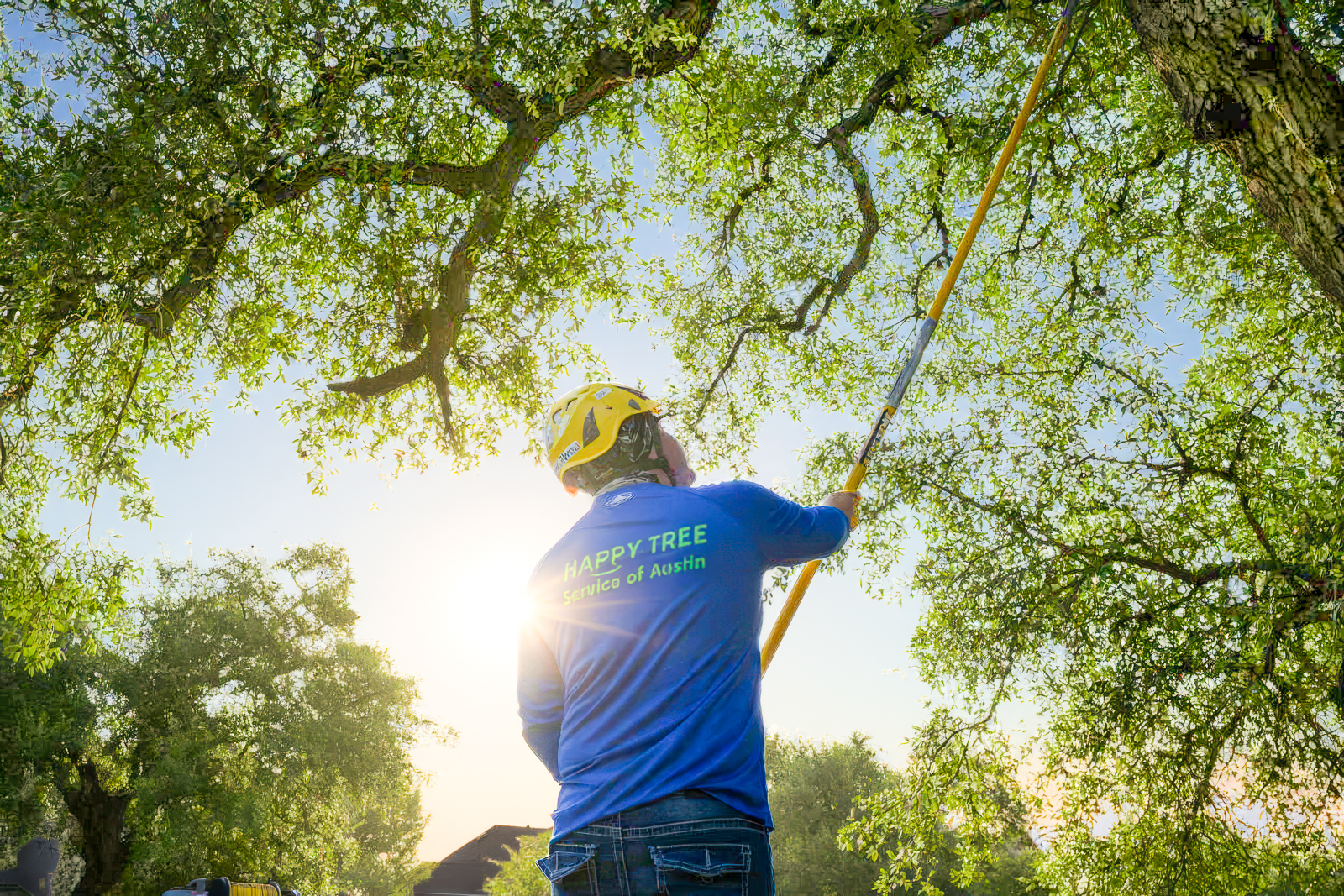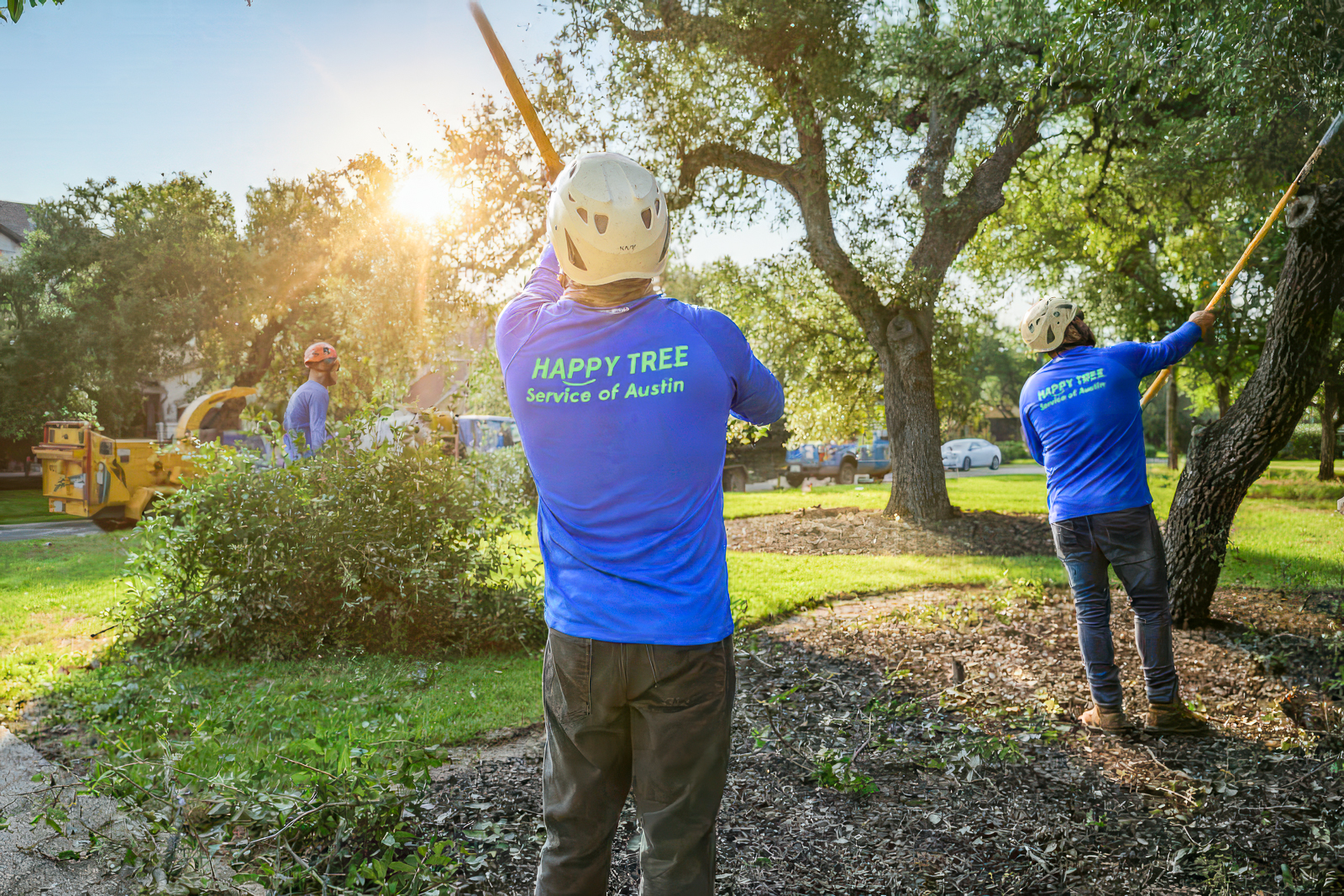Seasonal Tree Care in Austin, TX – Keep Your Trees Healthy All Year with ISA-Certified Arborists
![]() 230+ Google Reviews
230+ Google Reviews
Schedule an Appointment Today & Find Out Why Our Customers Consistently Rate Our Austin Tree Company 5 Stars: 512-212-0010.
![]() 230+ Google Reviews
230+ Google Reviews
Schedule an Appointment Today & Find Out Why Our Customers Consistently Rate Our Austin Tree Company 5 Stars: 512-212-0010.
Central Texas is one of the most challenging environments for trees in the country. Summers bring intense heat and drought, winters can deliver sudden freezes, and spring and fall often swing from storms to calm in the span of a week. These shifting conditions mean that trees are constantly under stress, and without proper care, even well-established species can decline.
That’s why seasonal tree care is essential in Austin. By aligning pruning, fertilization, and monitoring with natural growth cycles, you help your trees adapt and thrive. At Happy Tree Service of Austin, our ISA Certified Arborists are trusted tree healthcare experts Austin residents rely on, providing year-round tree services designed specifically for Central Texas conditions. With decades of local experience and a science-based approach, we tailor care to each season so your landscape stays safe, healthy, and beautiful.
Trees don’t have the same needs every month of the year. Effective care requires knowing when to prune, when to fertilize, and when to step back to avoid stressing the tree. Our seasonal approach combines certified expertise with ongoing observation of weather and soil conditions.
Tree growth cycles vary throughout the year. Pruning, fertilization, and disease prevention treatments are only effective when applied at the right time. For example, pruning oaks during spring can spread oak wilt, while fertilizing during peak summer heat wastes resources the tree cannot absorb. By timing services to natural cycles, we strengthen trees when they can benefit most.
No two years in Central Texas are alike. Some summers bring record drought, while others see unexpected rainstorms. Our arborists adjust care based on what’s happening in real time. That means tailoring watering plans during drought, prioritizing storm inspections after heavy winds, and scheduling fertilization when root systems can best absorb nutrients.
Tree health builds year over year. Fertilization in fall strengthens roots for spring growth. Pruning in winter reduces storm risks in summer. Seasonal visits are not quick fixes—they are part of a larger plan that compounds benefits and supports long-term resilience.
December through February may look like quiet months for trees, but dormancy is when some of the most important care should take place. The work done in winter sets the stage for strong spring growth and helps protect trees from sudden cold snaps.
Winter is the best season for heavy structural pruning, with our team offering expert tree prunning such as the removal of large limbs or crown reduction. There are several reasons for this. From spring through fall, your tree’s leaves are producing food, so it is best not to reduce the canopy during that period. Trees are also under stress from heat and drought in the growing season, and pruning then can add to that stress. After leaf drop, it is easier to see the tree’s branch structure, select limbs for reduction, and identify compromised branches that may pose safety concerns. By addressing weak limbs in winter, you lower the chance of failures during spring storms.
Central Texas winters can be unpredictable. A mild season can shift to a hard freeze overnight. Sensitive species such as palms, young citrus, and some ornamentals may need wrapping to protect them from sudden temperature drops. Our team evaluates vulnerable trees, recommends protective measures, and checks for storm damage after freezes to keep trees safe and healthy.
Winter is also an ideal time to prepare soil for the coming growing season. Poor soil quality is one of the biggest challenges for urban trees. Soil aeration and root zone treatments help ensure that spring rains can penetrate the ground and support healthy root systems. Soil testing during these months allows us to identify deficiencies and create fertilization schedules for early spring. By understanding pH levels, nutrient content, and compaction, we can develop a plan that encourages vigorous growth when warmer weather arrives.

Spring brings new life, but it also brings new risks. As trees break dormancy, they use immense amounts of energy to grow leaves, flowers, and fruit. Early detection of issues in this season prevents small problems from becoming major setbacks.
Fertilizing in early spring replenishes the nutrients trees expend during growth. Instead of guessing, we use soil test results from winter to determine exactly what your trees need. Customized fertilization ensures healthy canopies, strong roots, and balanced development.
Many tree pests and diseases emerge in spring. From fungal infections to insect infestations, this is the time when vigilance matters most. Our arborists inspect leaves, bark, and soil for early warning signs and intervene quickly when problems appear.
Spring storms in Austin can cause limb damage or broken branches. Corrective pruning, part of our Austin tree trimming services, removes these hazards and restores tree structure. By shaping growth after storms, we ensure trees develop balanced canopies instead of compensating with weak or unstable limbs.
From June through September, trees face the most extreme conditions. Long days of high heat and minimal rainfall make this the season where stress is most visible—and most dangerous.
During drought, surface watering is rarely enough to keep trees healthy. Our team can test the moisture level of your soil and develop a strategy to ensure your trees receive the right amount of water. Alongside irrigation strategies, our deep root fertilization services and Deep Root Watering are among the most effective ways to help trees not only survive but thrive during the intense summer heat.
This service uses a soil probe to deliver large volumes of water deep into the soil, reaching the tree’s entire critical root zone in a uniform way. The water is combined with a special blend of beneficial mycorrhizal fungi. These fungi form underground networks that attach to your tree’s root system and significantly increase its ability to absorb water and nutrients. Deep Root Watering provides immediate relief during drought while also improving long-term drought tolerance.
Mulching to Conserve Moisture
Mulch is a powerful tool during hot months, but only when applied correctly. We spread mulch to the proper depth and always keep it clear of the trunk to prevent rot. This helps soil retain moisture, regulates temperature, and protects root systems.
Leaves that curl, scorch, or drop early are signs of water stress. Sparse canopies or premature fruit drop may also indicate trouble. Our arborists teach property owners what to look for and provide immediate care strategies to reduce stress before decline sets in.
Deadwood Removal Before Leaf Drop
One of the most beneficial forms of pruning is the removal of deadwood. Dead limbs create entry points for insects and disease to bypass a tree’s natural defenses, and they also pose a significant safety risk to people and property below.
Late summer is an ideal time to address this essential aspect of tree care. By fall, when trees begin to shed their leaves, spotting dead limbs becomes more difficult. Making proper pruning cuts during the summer months allows your tree to start compartmentalizing those wounds quickly, improving overall health while reducing safety hazards.

If one season stands out as the most critical for long-term tree health in Austin, it’s fall. Cooler weather, moist soils, and lower stress create the best window for preventive care and planting.
Fall fertilization strengthens roots before trees go dormant. By delivering nutrients directly into the root zone, we give trees the reserves they need to withstand winter and flourish in spring. This proactive step is one of the most effective ways to support long-term health.
Fall is also the best time to perform oak wilt prevention treatments, guided by our certified oak wilt treatment experts. In cooler months, transpiration helps distribute fungicide through the tree’s vascular system. Treating at this time increases effectiveness and helps protect neighboring oaks from infection.
Our tree planting services Austin homeowners trust ensure fall planting allows new trees to establish roots in warm soil before summer returns. Native and adapted species planted during this window have a higher survival rate and grow stronger canopies long term. Our arborists guide property owners in selecting the right tree for the right place, ensuring growth without future conflicts.
Every tree responds differently to seasonal changes. Live oaks require strict pruning schedules to avoid oak wilt, while cedar elms thrive with periodic canopy thinning. Red oaks need preventive treatments timed carefully, and fruit trees like peaches benefit from winter pruning to encourage production. By adapting care to each species, we ensure that trees receive the right attention at the right time.
Understanding species-specific needs is especially important in Central Texas, where diverse landscapes combine native trees, ornamentals, and fruit-bearing varieties. What keeps one tree strong could seriously damage another if performed at the wrong time of year. Our ISA Certified Arborists bring species knowledge and local experience to create tailored care plans for each tree in your yard or commercial property.
Live oaks are some of the most iconic trees in Austin, but they are also highly vulnerable to oak wilt. This disease can spread quickly when pruning wounds are made at the wrong time of year. To prevent infection, live oaks should only be pruned from July through January, when fungal activity and insect transmission are lowest. Our arborists also apply wound paint immediately to every cut on oaks, further reducing the risk of disease spread.
Fruit trees such as peaches, plums, and pears respond best to pruning in late winter. This is the ideal time for structural pruning that strengthens the tree and prepares it to carry the weight of ripening fruit. Pruning during this season also ensures that sunlight can reach the developing fruit, improving both quality and yield. Proper pruning encourages healthier harvests and supports many years of vigorous production.
By timing care around the natural growth cycles of each species, we promote long-term tree health and reduce the risk of avoidable damage. Whether you are tending historic live oaks, shade-providing cedar elms, or fruit trees that supply annual harvests, Happy Tree Expert Tree Services & Arborist in Austin aligns pruning, fertilization, and treatment with the biology of the tree to deliver the best results.
Routine seasonal care does more than keep trees looking good—it prevents costly problems before they happen. Proactive maintenance reduces risks and strengthens trees for long-term resilience.
Pruning before storm season and monitoring soil conditions reduce the likelihood of sudden failures. Instead of scrambling after damage, seasonal care prepares trees to withstand stress, saving time and money.
Trees that receive consistent fertilization, pruning, and monitoring live longer and develop fuller, healthier canopies. This makes them more resistant to disease and pests and more valuable to the property overall.
Healthy, well-maintained trees improve the appearance and safety of any property. Whether for a home, HOA, or business, strong trees add value, reduce liability, and create inviting outdoor spaces.
Tree care is not a one-time task—it’s a year-round commitment. By aligning maintenance with seasonal needs, you protect your trees from the challenges of Central Texas weather and ensure they continue to provide shade, beauty, and value for years to come.
At Happy Tree Service of Austin, each Austin certified arborist on our team designs seasonal care plans tailored to your property. From winter pruning to fall planting, we deliver science-backed solutions that match the biology of your trees and the climate of Austin.
Call us today at 512-599-9948 or reach out online to schedule a free estimate. With proactive care from trusted local experts, your trees can thrive through every season.
Evan Peter, Certified Arborist – TX-4602A
Lewis Heye, Certified Arborist – TX-3510A

